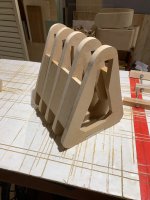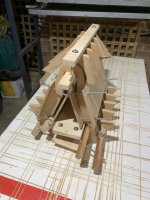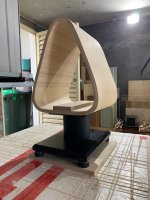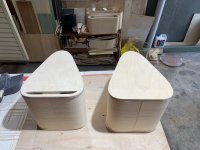I've asked the question on the multi-way forum, but will post here too. I would be keen to know what FR driver you would suggest for this smallish stand-mounted triangular prism speaker. As I burn in the Alpair 6.2s on my home streamer, I'm becoming increasingly a member of the FR fan club. Speaker dimensions and volume will follow the driver, but volume most likely in the 4-10 litre range. Keen to seek a similar sound to my B&W 607s3s with forward mids and sparkly highs while retaining good bass performance. Can be sealed, ported or even TL (if a TL in a triangle exists!).
Attachments
Thanks Dave, will chamfer the baffle.
Could you stick your neck out and suggest which 4" MA driver to go for? Or at least a couple with their pros and cons? With the miniOnkens I note that the slot size and position is an important component, could I have a round port facing forwards at the top of the triangle instead? If a slot is essential, it would go at the front base of the triangle. How long should I make it, as wide as the bottom or top of the triangle or somewhere in between?
Could you stick your neck out and suggest which 4" MA driver to go for? Or at least a couple with their pros and cons? With the miniOnkens I note that the slot size and position is an important component, could I have a round port facing forwards at the top of the triangle instead? If a slot is essential, it would go at the front base of the triangle. How long should I make it, as wide as the bottom or top of the triangle or somewhere in between?
I’d run a slot out the bototm.
This is 9 litre… you might be able to morph it into your shape.
https://frugal-phile.com/boxlib/P10free/CGR-dPlu-Ken7HD-0v81-240123.pdf
dave
This is 9 litre… you might be able to morph it into your shape.
https://frugal-phile.com/boxlib/P10free/CGR-dPlu-Ken7HD-0v81-240123.pdf
dave
I'm finding that 15mm baltic birch ply supplies in Australia have declined in quality since the Russian trade embargo (especially problematic when kerfing) so this time around I'm planning to use 2mm "bendy ply" which can be tightly curved and glue laminated around a form to achieve any desired thickness. Patience and plenty of glue needed! So this would need about 6 layers which (with glue) would achieve about 15mm thickness. 12mm thick would mean less glue and less material. Hoping no brace needed because of the shape.
Understood re the vent, I could use double-sided tape to fix the vent spacers temporarily until happy. I will have a removable rear baffle for adjustments.
I've just run some rough volume calculations (triangular prism volume=1/2BHD excluding adjustment for rounded corners) and the triangle would need to be 303mm high x 233 wide (at the base) x 260 deep to achieve 9.18 litres (all measurements internal) while keeping good visual proportions for the Pluvia 7HD. Height and width are not so different from the CGR (332h x 212w) but depth is more than double the CGR (120mm in the CGR, 260mm in the triangle). This is because you lose a lot of volume as the triangle's sides converge at the top. Will this be an issue?
Understood re the vent, I could use double-sided tape to fix the vent spacers temporarily until happy. I will have a removable rear baffle for adjustments.
I've just run some rough volume calculations (triangular prism volume=1/2BHD excluding adjustment for rounded corners) and the triangle would need to be 303mm high x 233 wide (at the base) x 260 deep to achieve 9.18 litres (all measurements internal) while keeping good visual proportions for the Pluvia 7HD. Height and width are not so different from the CGR (332h x 212w) but depth is more than double the CGR (120mm in the CGR, 260mm in the triangle). This is because you lose a lot of volume as the triangle's sides converge at the top. Will this be an issue?
Well, a busy four weeks later here they are complete with matching white MAOP 7.2 drivers. Build and sound report to follow, but the MAOPs are already sounding silky smooth after just 24 hours. Do they need 100 hours run-in like the others?

Last edited by a moderator:
Do they need 100 hours run-in like the others?
Yes.
Quite pretty, good work.
dave
So after the 100hr run-in here's a quick user report and review on my rounded triangle speakers powered by Mark Audio MAOP7s supplied by Darcher. Also some suggestions on DIY speaker parts and suppliers for Australian speaker builders (no personal or financial connections with any supplier).
Design
The goal here was to have some fun with rounded triangles. As Dave confirmed above, the shape should not harm the sound and might even benefit it. Curves (to me at least) convey calm, relaxation and fun while boxes can look a bit serious and are not always easy to blend into a multipurpose space. New materials (in this case bendy ply) means the DIY-er can experiment with curved shapes in a way that the big manufacturers generally don't. Anyone can build a rectangular box, so why not try something different? The volume, dimensions and port design were based on Dave's Classic Golden Ratios as per his suggestion. The front port was split into left and right ports with a central vent spacer. No internal bracing necessary due to the shape. Volume just under 10 litres if my trapezoid volume calculations are correct...
Construction
In a word, tricky. This build would not have been possible without a new product, namely 2mm thick bendy plywood made in China from paulownia. It was sourced from Trademaster in western Sydney. Its key feature is extreme bendiness in either direction and suitability for glue lamination. I built a triangular form out of MDF with matching felt-lined plywood corner clamps to apply pressure at the corners. It looked like something out of the Alien movie!
I bent and glued seven layers of ply into the rounded triangular shape (one at a time every 24 hours allowing glue to dry and water to evaporate) giving 15mm panel thickness including glue. Water was brushed onto the outside of each ply sheet to aid bending while glue was applied to the inside. Getting the right mix of water and glue so that they didn't soak too far into the ply and dilute each other was difficult at first but easy one the right amount for each had been found. The vent spacer acted as the start and finish point for the ply using wooden screw clamps to hold the ply to the spacer. Front and rear baffles were of 19mm ply with the front baffle glued and rear baffle screwed to allow for later fine-tuning if needed. Twelve rolled-on coats of white Dulux Aquanamel inside and out. Very solid and sturdy with a satin sheen. Jantzen speaker-binding plate and posts at the rear from Speaker Bug.
The damping material was the hardest thing to source in Australia. I followed Scott's recommendation to only use either fibreglass or natural materials. I looked at fiberglass (only available in huge hay-bale sizes), carpet underlay (only artificial ones used these days), cushion and furniture filling (not available in the right thickness or material) and even jute worm farm lining! In the end I found some ideal natural felt (80% wool, 20% viscose) from a felt supplier in Melbourne called JJ Davies. It was called navy saddle felt and is used mostly under horse saddles. But at 9mm thick and beautifully rich and dense, it was ideal for speaker damping. Apparently several commercial speaker builders in Australia use it.
Listening Impressions
In a word, glorious!
Paired with my Bluesound Powernode 2i, at first the speakers sounded subdued, but I soon discovered an air leak where the rear panel was screwed into the side walls. The rubber draught excluder I had used to seal the rear had twisted during the sealing process leaving an air gap. Once this had been rectified I had to be patient for the compulsory 100-hour run-in (please can this be shortened!). But even during the run-in the speakers sounded sweet and composed.
Mid and upper range are remarkable for a full range driver of this size and while the bass is not the deepest, it is agile and non-fatiguing, balacing well with mid and upper ranges to produce a well-rounded sound. Sound stage is wide with the speakers 6ft apart. Dave mentioned the port might need to be modified for my design but I see (and hear) no need. I may experiment with a sub in due course but very happy with just my two triangles.
By comparison to my B&W 607 S3's the triangles don't have the V-shape or the bass response of the B&W's, so in one sense are less "exciting" but in another sense are easier on the ear for longer listening periods. I'm glad I went for the MAOP 7 over the Alpairs and really glad I went for full range over multi-range.
Some photos below. So thanks Scott and Dave for a great product, great support and great advice.
Attachments
Last edited:
Added two round metal grilles this week to protect the drivers from cat claws in their new home. Not as pretty as the exposed MAOP 7.2 drivers but they should last longer. Black automotive metal grille sheet cut into circles and encased in rebated plywood frames with thin U-shaped auto rubber wrapped around the grille edges to reduce vibrations. Five small magnets on the reverse to cling tightly to the hex screw heads. No adverse sound impacts that I can tell so far. Sounding even better now they have passed the 100-hour mark.


- Home
- Loudspeakers
- Full Range
- Full Range Triangle








